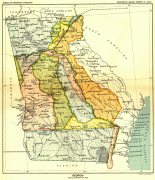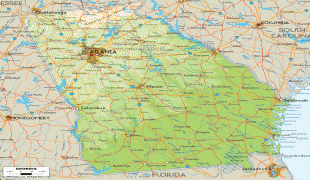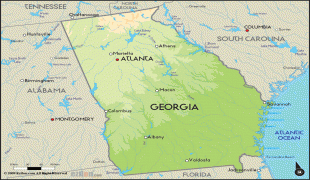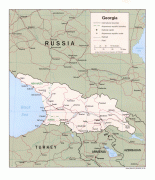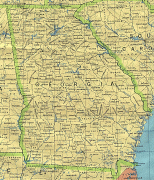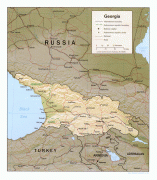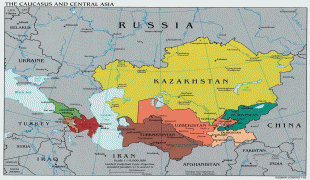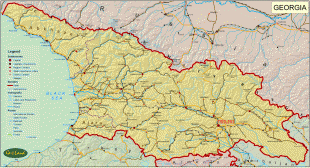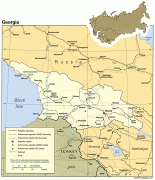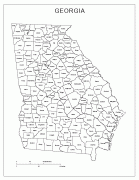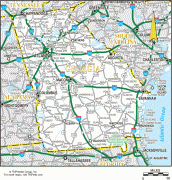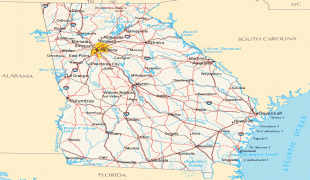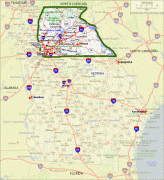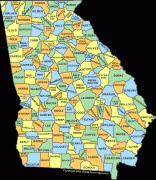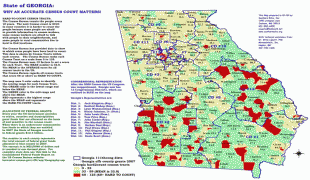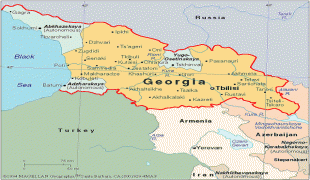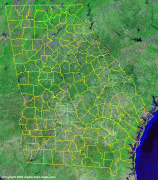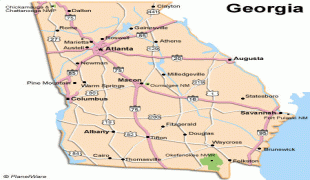Georgia (Georgia)
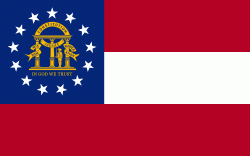 |
 |
Founded in 1732 as the Province of Georgia and first settled in 1733, Georgia became a British royal colony in 1752. It was the last and southernmost of the original Thirteen Colonies to be established. Named after King George II of Great Britain, the Georgia Colony covered the area from South Carolina south to Spanish Florida and west to French Louisiana at the Mississippi River. On January 2, 1788, Georgia became the fourth state to ratify the United States Constitution. From 1802 to 1804, western Georgia was split to form the Mississippi Territory, which later was admitted as the U.S. states of Alabama and Mississippi. Georgia declared its secession from the Union on January 19, 1861, and was one of the original seven Confederate States. Following the Civil War, it was the last state to be restored to the Union, on July 15, 1870. In the post-Reconstruction era of the late 19th century, Georgia's economy was transformed as a group of prominent politicians, businessmen, and journalists, led by Henry W. Grady, espoused the "New South" philosophy of sectional reconciliation, industrialization, and white supremacy. During the mid-20th century, several Georgians, most notably Martin Luther King Jr., were prominent leaders during the civil rights movement. Atlanta was selected as host of the 1996 Summer Olympics, which marked the 100th anniversary of the modern Olympic Games. Since 1945, Georgia has seen substantial population and economic growth as part of the broader Sun Belt phenomenon. From 2007 to 2008, 14 of Georgia's counties ranked among the nation's 100 fastest-growing.
Georgia is defined by a diversity of landscapes, flora, and fauna. The state's northernmost regions include the Blue Ridge Mountains, part of the larger Appalachian Mountain system. The Piedmont plateau extends from the foothills of the Blue Ridge south to the Fall Line, an escarpment to the Coastal Plain defining the state's southern region. Georgia's highest point is Brasstown Bald at 4,784 feet (1,458 m) above sea level; the lowest is the Atlantic Ocean. With the exception of some high-altitude areas in the Blue Ridge, the entirety of the state has a humid subtropical climate. Of the states entirely east of the Mississippi River, Georgia is the largest in land area.
Before settlement by Europeans, Georgia was inhabited by the mound building cultures. The British colony of Georgia was founded by James Oglethorpe on February 12, 1733. The colony was administered by the Trustees for the Establishment of the Colony of Georgia in America under a charter issued by (and named for) King George II. The Trustees implemented an elaborate plan for the colony's settlement, known as the Oglethorpe Plan, which envisioned an agrarian society of yeoman farmers and prohibited slavery. The colony was invaded by the Spanish in 1742, during the War of Jenkins' Ear. In 1752, after the government failed to renew subsidies that had helped support the colony, the Trustees turned over control to the crown. Georgia became a crown colony, with a governor appointed by the king.
The Province of Georgia was one of the Thirteen Colonies that revolted against British rule in the American Revolution by signing the 1776 Declaration of Independence. The State of Georgia's first constitution was ratified in February 1777. Georgia was the 10th state to ratify the Articles of Confederation on July 24, 1778, and was the 4th state to ratify the United States Constitution on January 2, 1788.
After the Creek War (1813–1814), General Andrew Jackson forced the Muscogee (Creek) tribes to surrender land to the state of Georgia, including in the Treaty of Fort Jackson (1814), surrendering 21 million acres in what is now southern Georgia and central Alabama, and the Treaty of Indian Springs (1825). In 1829, gold was discovered in the North Georgia mountains leading to the Georgia Gold Rush and establishment of a federal mint in Dahlonega, which continued in operation until 1861. The resulting influx of white settlers put pressure on the government to take land from the Cherokee Nation. In 1830, President Andrew Jackson signed the Indian Removal Act, sending many eastern Native American nations to reservations in present-day Oklahoma, including all of Georgia's tribes. Despite the Supreme Court's ruling in Worcester v. Georgia (1832) that U.S. states were not permitted to redraw Indian boundaries, President Jackson and the state of Georgia ignored the ruling. In 1838, his successor, Martin Van Buren, dispatched federal troops to gather the tribes and deport them west of the Mississippi. This forced relocation, known as the Trail of Tears, led to the death of more than four thousand Cherokees.
In early 1861, Georgia joined the Confederacy (with secessionists having a slight majority of delegates) and became a major theater of the Civil War. Major battles took place at Chickamauga, Kennesaw Mountain, and Atlanta. In December 1864, a large swath of the state from Atlanta to Savannah was destroyed during General William Tecumseh Sherman's March to the Sea. 18,253 Georgian soldiers died in service, roughly one of every five who served. In 1870, following the Reconstruction era, Georgia became the last Confederate state to be restored to the Union.
With white Democrats having regained power in the state legislature, they passed a poll tax in 1877, which disenfranchised many poor black (and some white) people, preventing them from registering. In 1908, the state established a white primary; with the only competitive contests within the Democratic Party, it was another way to exclude black people from politics. They constituted 46.7% of the state's population in 1900, but the proportion of Georgia's population that was African American dropped thereafter to 28%, primarily due to tens of thousands leaving the state during the Great Migration. According to the Equal Justice Initiative's 2015 report on lynching in the United States (1877–1950), Georgia had 531 deaths, the second-highest total of these extralegal executions of any state in the South. The overwhelming number of victims were black and male. Political disfranchisement persisted through the mid-1960s, until after Congress passed the Voting Rights Act of 1965.
An Atlanta-born Baptist minister who was part of the educated middle class that had developed in Atlanta's African-American community, Martin Luther King Jr., emerged as a national leader in the civil rights movement. King joined with others to form the Southern Christian Leadership Conference (SCLC) in Atlanta in 1957 to provide political leadership for the Civil Rights Movement across the South. The civil rights riots of the 1956 Sugar Bowl would also take place in Atlanta after a clash between Georgia Tech's president Blake R. Van Leer and Governor Marvin Griffin.
On February 5, 1958, during a training mission flown by a B-47, a Mark 15 nuclear bomb, also known as the Tybee Bomb, was lost off the coast of Tybee Island near Savannah. The bomb was thought by the Department of Energy to lie buried in silt at the bottom of Wassaw Sound.
Map - Georgia (Georgia)
Map
Country - United_States
 |
 |
| Flag of the United States | |
Indigenous peoples have inhabited the Americas for thousands of years. Beginning in 1607, British colonization led to the establishment of the Thirteen Colonies in what is now the Eastern United States. They quarreled with the British Crown over taxation and political representation, leading to the American Revolution and proceeding Revolutionary War. The United States declared independence on July 4, 1776, becoming the first nation-state founded on Enlightenment principles of unalienable natural rights, consent of the governed, and liberal democracy. The country began expanding across North America, spanning the continent by 1848. Sectional division surrounding slavery in the Southern United States led to the secession of the Confederate States of America, which fought the remaining states of the Union during the American Civil War (1861–1865). With the Union's victory and preservation, slavery was abolished nationally by the Thirteenth Amendment.
Currency / Language
| ISO | Currency | Symbol | Significant figures |
|---|---|---|---|
| USD | United States dollar | $ | 2 |
| ISO | Language |
|---|---|
| EN | English language |
| FR | French language |
| ES | Spanish language |






